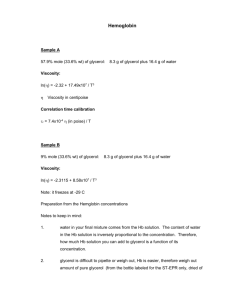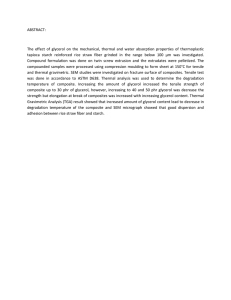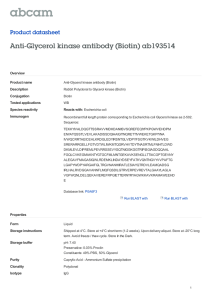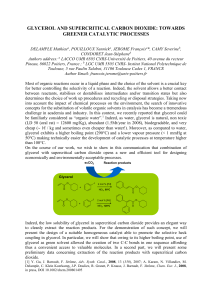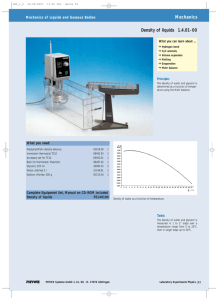Disorders of Glycerol Metabolism 17
advertisement
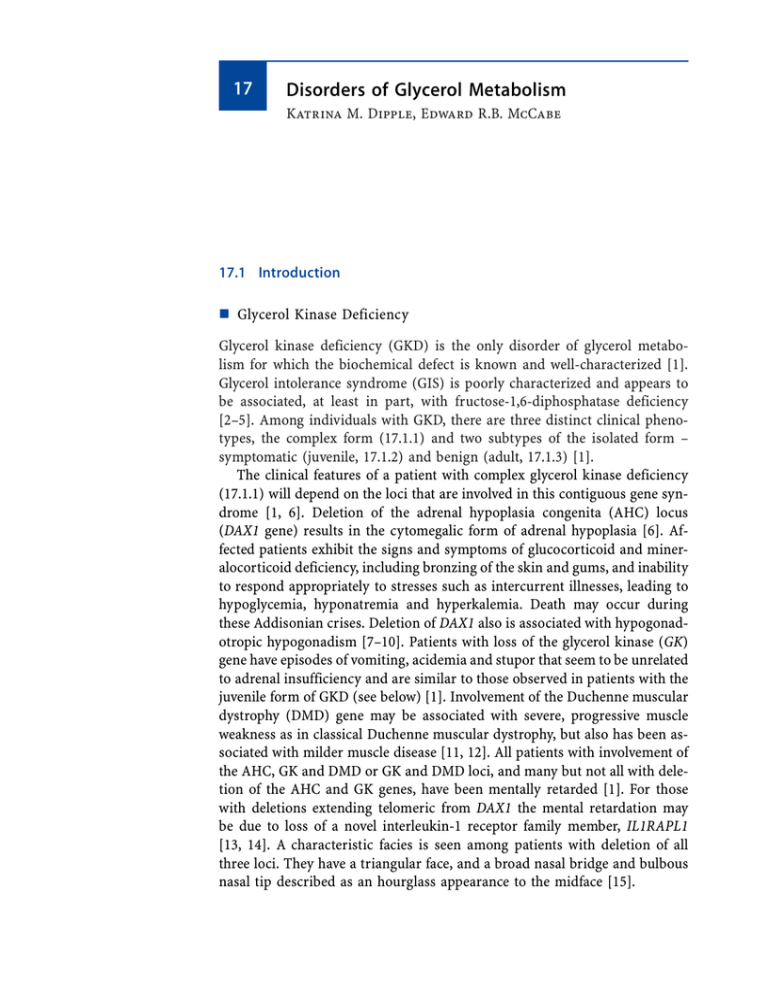
17 Disorders of Glycerol Metabolism Katrina M. Dipple, Edward R.B. McCabe 17.1 Introduction n Glycerol Kinase Deficiency Glycerol kinase deficiency (GKD) is the only disorder of glycerol metabolism for which the biochemical defect is known and well-characterized [1]. Glycerol intolerance syndrome (GIS) is poorly characterized and appears to be associated, at least in part, with fructose-1,6-diphosphatase deficiency [2–5]. Among individuals with GKD, there are three distinct clinical phenotypes, the complex form (17.1.1) and two subtypes of the isolated form – symptomatic (juvenile, 17.1.2) and benign (adult, 17.1.3) [1]. The clinical features of a patient with complex glycerol kinase deficiency (17.1.1) will depend on the loci that are involved in this contiguous gene syndrome [1, 6]. Deletion of the adrenal hypoplasia congenita (AHC) locus (DAX1 gene) results in the cytomegalic form of adrenal hypoplasia [6]. Affected patients exhibit the signs and symptoms of glucocorticoid and mineralocorticoid deficiency, including bronzing of the skin and gums, and inability to respond appropriately to stresses such as intercurrent illnesses, leading to hypoglycemia, hyponatremia and hyperkalemia. Death may occur during these Addisonian crises. Deletion of DAX1 also is associated with hypogonadotropic hypogonadism [7–10]. Patients with loss of the glycerol kinase (GK) gene have episodes of vomiting, acidemia and stupor that seem to be unrelated to adrenal insufficiency and are similar to those observed in patients with the juvenile form of GKD (see below) [1]. Involvement of the Duchenne muscular dystrophy (DMD) gene may be associated with severe, progressive muscle weakness as in classical Duchenne muscular dystrophy, but also has been associated with milder muscle disease [11, 12]. All patients with involvement of the AHC, GK and DMD or GK and DMD loci, and many but not all with deletion of the AHC and GK genes, have been mentally retarded [1]. For those with deletions extending telomeric from DAX1 the mental retardation may be due to loss of a novel interleukin-1 receptor family member, IL1RAPL1 [13, 14]. A characteristic facies is seen among patients with deletion of all three loci. They have a triangular face, and a broad nasal bridge and bulbous nasal tip described as an hourglass appearance to the midface [15]. 370 Disorders of Glycerol Metabolism The symptomatic form of isolated glycerol kinase deficiency (Juvenile form, 17.1.2) presents in early childhood. Affected boys have had hypothermia and lethargy beginning in the first week of life, but more generally have episodic vomiting at 2 to 6 years of age associated variably with acidemia, central nervous system depression, including lethargy, somnolence, stupor and unconsciousness, and hypoglycemia, interpreted by some as a Reye-like illness [1]. The benign form (Adult GKD, 17.1.3) of isolated glycerol kinase deficiency is not associated with the episodic metabolic and CNS deteriorations seen with the other forms. Males with this biochemical phenotype are identified incidentally with pseudohypertriglyceridemia, when routine laboratory studies incorrectly identify the elevated free glycerol concentration in their blood as triglycerides [1]. These individuals have increased levels of glycerol in blood and urine and may be at increased risk of type 2 diabetes mellitus [16]. n Diagnosis Hyperglycerolemia and glyceroluria are features of glycerol kinase deficiency [1]. Although glycerol is not an acidic compound, glyceroluria generally comes to attention during evaluation of urine organic acids by gas chromatography/mass spectrometry, if a solvent extraction method is used. The enzyme deficiency can be confirmed by assay in a variety of tissues, including leukocytes, transformed lymphoblastoid cells, cultured fibroblasts, liver, kidney, small intestine and cultured amniocytes [1]. Patients with complex glycerol kinase deficiency will have a deletion of the GK gene that may be large enough to be seen by classical cytogenetic evaluation, but certainly can be identified by molecular genetic and molecular cytogenetic methods, including fluorescence in situ hybridization (FISH) [1, 17]. Because of the importance of recognizing the involvement of contiguous genes for prognosis, counseling and management, it is important to ascertain whether an individual with GKD also has involvement of the AHC and DMD loci. This can readily be accomplished by evaluation of plasma ACTH and serum creatine phosphokinase (CPK) [1, 6]. If either is significantly elevated, then additional studies are indicated. FISH for deletion of the AHC region is now possible [9]. n Glycerol Intolerance Syndrome (GIS) Patients with GIS have episodes remarkably similar to those observed among patients with GKD, but patients with GIS have normal GK enzymatic activity [1]. The episodes consist of sweating, irritability, confusion, lethargy and coma, with hypoglycemia and seizures observed on occasion Metabolic Pathway 371 [2–5, 18]. Episodes have been precipitated by glycerol infusion or ingestion [2–4, 18]. Male and female patients have been described. Several recent reports indicate partial or complete deficiency of fructose-1,6-diphosphatase (FDP) [2–4], though this activity was normal in another patient [18]. One patient with FDP deficiency presented with glycerolemia, hypoglycemia and ketosis, which was at first thought to be GIS [5]. 17.2 Nomenclature No. Disorder-affected component Tissue distribution 17.1 Glycerol kinase Leukocytes, lymphoblastoid deficiency (17.1.1, cells, fibroblasts, liver, kidney, 17.1.2, and 17.1.3) small intestine, adrenal, cultured amniocytes Chromosomal localisation McKusick Xp21 307030 17.3 Metabolic Pathway Fig. 17.1. Metabolism of glycerol. 17.1, Glycerol kinase; cGPDH (NAD), cytoplasmic NAD-linked glycerol-3-phosphate dehydrogenase; mGPDH (FAD), mitochondrial FADlinked glycerol-3-phosphate dehydrogenase. Dihydroxyacetone-phosphate is an intermediate in the glycolytic pathway as well as a precursor for plasmalogens 372 Disorders of Glycerol Metabolism 17.4 Signs and Symptoms Table 17.1. Complex GKD (1) (>50 Patients) System Signs/symptoms Neonatal Infancy Childhood Adolescence Adulthood Characteristic clinical findings Dysmorphic Mental retardation Short stature Triglycerides a (s) Glucose b (s) pH b (B) Creatinine kinase(s) Glycerol (u) Glycerol (s) ACTH (P) Strabismus Abnormal ERG Vomiting b Weakness Pseudohypertrophy Osteoporosis Pathological fractures Adrenal hypoplasia Addisonian pigmentation Abnormal c Depressed level of consciousness b Seizures ± ± ± : ; ; ±: : : ±: ± + + ± ± ± ± ± ± ± + ± ± ± ± : ; ; ±: : : ±: ± + + ± ± ± ± ± ± ± + ± Routine laboratory Special laboratory Eye GI Musculoskeletal Bone Endocrine Dermatological Genitalia CNS ± ± ± : ; ; ±: : : ±: ± + + ± ± ± ± ± ± ± + ± ± ± ± : ; ; ±: : : ±: ± + + ± ± ± ± ± ± ± + ± ± ± ± : ? ; ±: : : ±: ± + ? ± ± ± ± ± ± ± ? ? a Pseudohypertriglyceridemia due to elevated free glycerol. Episodic. c Abnormal genitalia include anorchia, cryptorchidism. d May improve with decreased glycerol intake. b Table 17.2. Juvenile GKD (6 Patients) System Signs/symptoms Neonatal Infancy Childhood Adolescence Adulthood Characteristic clinical findings Routine laboratory Mental retardation d Seizures Triglycerides a (s) Glucose b (s) pH b (B) Glycerol (u) Glycerol (s) EEG d Vomiting b Depressed level of consciousness b ± ± : ; ; : : ± ± : ; ; : : ± ± : ; ; : : ? ? : ; ; : : + + + + + + + + Special laboratory GI CNS a Pseudohypertriglyceridemia due to elevated free glycerol. Episodic. c Abnormal genitalia include anorchia, cryptorchidism. d May improve with decreased glycerol intake. b ± ± : ; ; : : ± + + Loading Tests 373 Table 17.3. Adult GKD (>25 Patients) a System Signs/symptoms Neonatal Infancy Childhood Adolescence Adulthood Characteristic clinical findings Routine laboratory Special laboratory Obesity (: Body mass) Triglycerides a (s) Glycerol (u) Glycerol (s) Glucose ? ? ? ? : : : ? ? ? : : : : : [16] Pseudohypertriglyceridemia due to elevated free glycerol. 17.5 Reference Values Age Glycerol (u) (mM) Glycerol (u) (mmol/mol creat) Glycerol (s) (mM) Not specified £ 0.2 not detectable 0.02–0.27 Values taken from McCabe [1]. 17.6 Pathological Values/Differential Diagnosis Disorder Glycerol (u) (mmol/l) Glycerol (u) (mmol/mol creat) Glycerol (s) (mmol/l) 17.1 GKD a (17.1.1, 17.1.2, and 17.1.3) 41–345 90–193 1.8–8.3 a Values taken from McCabe [1]. No differences have been noted with the different phenotypes [1]. 17.7 Loading Tests Not indicated – may cause severe CNS symptomatology. 374 Disorders of Glycerol Metabolism 17.8 Diagnostic Flow Chart Glycerol CPK ACTH Glycerol CPK ACTH (N) Glycerol CPK (N) ACTH Glycerol CPK (N) ACTH (N) Complex GKD AHC + GKD + DMD Complex GKD GKD + DMD Complex GKD GKD + AHC Clinical episodes Y N Juvenile GKD Adult GKD Molecular genetic and molecular cytogenic studies * Urine glycerol can be elevated from glycerol-containing emolients applied to perineum or glycerin suppositories contaminating bagged urine specimens 17.9 Specimen Collection Test Preconditions Material Glycerol (u) None Random or 24 h Keep cool or frozen Glycerol (s, p) None Serum/plasma Handling Pitfalls Contamination by emolients or glycerin suppository Some rubber stoppers in vacuum tubes use glycerol as lubricant Keep cool or frozen 17.10 Prenatal Diagnosis Disorder Material Timing, trimester Ref. 17.1 Amniocytes II 1 17.11 DNA Analysis Disorder Tissue/specimen Method Ref. 17.1 WBC, lymphoblastoid cell lines, fibroblasts, amniocytes PCR and sequencing, FISH 1 Research testing not clinical References 375 17.12 Initial Treatment (Management while Awaiting Results) If the patient is acutely ill with vomiting and/or CNS depression, start IV solution containing glucose, evaluate blood pH and serum electrolytes, draw blood for ACTH, and if concerned about adrenal insufficiency consider initiating glucocorticoid and mineralcorticoid treatment. 17.13 Summary/Comments The differential diagnosis of glycerol kinase deficiency depends on ascertaining whether or not the patient has a contiguous gene syndrome. If the GK gene is deleted by molecular genetic and/or molecular cytogenetic studies, it is important to determine the extent of the deletion, and, particularly, whether the DAX1 gene is involved, since all deaths have resulted from adrenal insufficiency. If glyceroluria and/or hyperglycerolemia are determined incidentally in a young child without a history of episodic decompensation, it may be difficult to know whether or not he has the symptomatic or benign form of the disorder. Patients with GIS should be tested for FDP deficiency. References 1. E. R. B. McCabe: Disorders of glycerol metabolism. The Metabolic and Molecular Bases of Inherited Disease. 8th Edition. C. R. Scriver, A. L. Beaudet, W. S. Sly, D. Valle, B. Childs, and B. Vogelstein, editors. New York: McGraw-Hill, 2001. 2. L. Baker and A. I. Winegrad: Fasting hypoglycaemia and metabolic acidosis associated with deficiency of hepatic fructose-1,6-diphosphatase activity. Lancet 2:13–16, 1970. 3. R. A. Wapnir, F. Lifshitz, C. Sekaran, S. Teichberg, and S. A. Moak: Glycerol-induced hypoglycemia: A syndrome associated with multiple liver enzyme deficiencies. Clinical and in vitro studies. Metabolism 31:1057, 1982. 4. P. Fort, R. A. Wapnir, F. De Rosas, and F. Lifshitz: Long-term evolution of glycerol intolerance syndrome. J Pediatr 106:453, 1985. 5. M. E. Beatty, Y.-H. Zhang, E. R. B. McCabe, and R. D. Steiner: Fructose-1,6-diphosphatase deficiency and glyceroluria: one possible etiology for GIS. Mol Genet Metab 69:338–340, 2000. 6. E. R. B. McCabe: Adrenal hypoplasias and aplasias. The Metabolic and Molecular Bases of Inherited Disease. 8th Edition. C. R. Scriver, A. L. Beaudet, W. S. Sly, D. Valle, B. Childs, and B. Vogelstein, editors. New York: McGraw-Hill, 2001. 7. E. Zanaria, F. Muscatelli, B. Bardoni, T. M. Strom, S. Guioli, W. Guo, E. Lalli, C. Moser, A. P. Walker, E. R. B. McCabe, T. Meitinger, A. P. Monaco, P. Sassone-Corsi, and G. Camerino: An unusual member of the nuclear hormone receptor superfamily responsible for X-linked adrenal hypoplasia congenita. Nature 372:635–641, 1994. 8. F. Muscatelli, T. M. Strom, A. P. Walker, E. Zanaria, D. Recan, A. Meindl, B. Bardoni, S. Guioli, G. Zehetner, W. Rabl, H. P. Schwarz, J.-C. Kaplan, G. Camerino, T. Meitin- 376 9. 10. 11. 12. 13. 14. 15. 16. 17. 18. Disorders of Glycerol Metabolism ger, and A. P. Monaco: Mutations in the DAX-1 gene give rise to both X-linked adrenal hypoplasia congenita and hypogonadotropic hypogonadism. Nature 372:672– 676, 1994. W. Guo, J. S. Mason, C. G. Stone, Jr., S. A. Morgan, S. I. Madu, A. Baldini, E. A. Lindsay, L. G. Biesecker, K. C. Copeland, M. N. B. Horlick, A. L. Pettigrew, E. Zanaria, and E. R. B. McCabe: Diagnosis of X-linked adrenal hypoplasia congenita by mutation analysis of the DAX1 gene. J Amer Med Soc 274:324–330, 1995. R. L. Habiby, P. Boepple, L. Nachtigall, P. M. Sluss, W. F. Crowley Jr., and J. L. Jameson: Adrenal hypoplasia congenita with hypogonadotropic hypogonadism: Evidence that DAX-1 mutations lead to combined hypothalamic and pituitary defects in gonadotropin production. J Clin Invest 98:1055–1062, 1996. M. A. Guggenheim, E. R. B. McCabe, M. Roig, S. I. Goodman, G. M. Lum, W. W. Bullen, and S. P. Ringel: Glycerol kinase deficiency with neuromuscular, skeletal and adrenal abnormalities. Ann Neurol 7:441–449, 1980. E. R. B. McCabe, J. Towbin, J. Chamberlain, L. Baumbach, J. Witkowski, G. J. B. van Ommen, M. Koenig, L. M. Kunkel, and W. K. Seltzer: Complementary DNA probes for the Duchenne muscular dystrophy locus demonstrate a previously undetectable deletion in a patient with dystrophic myopathy, glycerol kinase deficiency and congenital adrenal hypoplasia. J Clin Invest 83:95–99, 1989. A. Carrié, L. Jun, T. Bienvenu, M.-C. Vinet, N. McDonell, P. Couvert, R. Zemni, A. Cardona, G. Van Buggenhout, S. Frints, B. Hamel, C. Moraine, H. H. Ropers, T. Strom, G. R. Howell, A. Whittaker, M. T. Ross, A. Kahn, J.-P. Fryns, C. Beldjord, P. Marynen, and J. Chelly: A new member of the IL-1 receptor family highly expressed in hippocampus and involved in X-linked mental retardation. Nat Genet 23:25–31, 1999. H. Jin, R. J. Gardner, R. Viswesvaraiah, F. Muntoni, and R. G. Roberts: Two novel members of the interleukin-1 receptor gene family, one deleted in Xp22.1-Xp21.3 mental retardation. European Journal of Human Genetics 8:87–94, 2000. A. Scheuerle, F. Greenberg, and E. R. B. McCabe: Dysmorphic features in patients with complex glycerol kinase deficiency. J Pediat 126:764–767, 1995. D. Gaudet, S. Arsenault, L. Pérusse, M.-C. Vohl, J. St.-Pierre, J. Bergeron, J.-P. Després, K. Dewar, M. J. Daly, T. Hudson, and J. D. Rioux: Glycerol as a correlate of impaired glucose tolerance: Dissection of a complex system by use of a simple genetic trait. Amer J Hum Genet 66:1558–1568, 2000. K. C. Worley, E. A. Lindsay, W. Bailey, J. Wise, E. R. B. McCabe, and A. Baldini. Rapid molecular cytogenetic analysis of X-chromosomal microdeletions: fluorescence in situ hybridization (FISH) for complex glycerol kinase deficiency. Amer J Med Genet 57:615–619, 1995. N. K. Maclaren, C. Cowles, P. T. Ozand, R. Shuttee, and M. Cornblath: Glycerol intolerance in a child with intermittent hypoglycemia. J Pediat 86:43, 1975.

